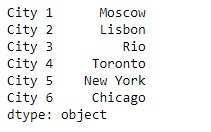Pandas 系列是带有轴标签的一维ndarray。标签不必是唯一的,但必须是可哈希的类型。该对象同时支持基于整数和基于标签的索引,并提供了许多方法来执行涉及索引的操作。
Pandas Series.sort_index()函数用于对给定系列对象的索引标签进行排序。
用法: Series.sort_index(axis=0, level=None, ascending=True, inplace=False, kind=’quicksort’, na_position=’last’, sort_remaining=True)
参数:
axis:轴直接排序。对于系列,只能为0。
level:如果不是None,则对指定索引级别中的值进行排序。
ascending:升序与降序排序。
inplace:如果为True,则就地执行操作。
kind:选择排序算法。
na_position:参数“ first”将NaN放在开头,“ last”将NaN放在结尾。
sort_remaining:如果为true且按级别和索引排序是多级别,则在按指定级别排序后也按其他级别(按顺序)排序。
返回:系列
范例1:采用Series.sort_index()函数对给定系列对象的索引标签进行排序。
# importing pandas as pd
import pandas as pd
# Creating the Series
sr = pd.Series(['New York', 'Chicago', 'Toronto', 'Lisbon', 'Rio', 'Moscow'])
# Create the Index
index_ = ['City 5', 'City 6', 'City 4', 'City 2', 'City 3', 'City 1']
# set the index
sr.index = index_
# Print the series
print(sr)输出:

现在我们将使用Series.sort_index()函数对给定系列对象的索引标签进行排序。
# sort the index labels
sr.sort_index()输出:

正如我们在输出中看到的,Series.sort_index()函数已成功对给定系列对象的索引标签进行了排序。
范例2:采用Series.sort_index()函数对给定系列对象的索引标签进行排序。
# importing pandas as pd
import pandas as pd
# Creating the Series
sr = pd.Series([19.5, 16.8, 22.78, 20.124, 18.1002])
# Create the Index
index_ = [5, 3, 2, 1, 4]
# set the index
sr.index = index_
# Print the series
print(sr)输出:

现在我们将使用Series.sort_index()函数对给定系列对象的索引标签进行排序。
# sort the index labels
sr.sort_index()输出:

正如我们在输出中看到的,Series.sort_index()函数已成功对给定系列对象的索引标签进行了排序。
相关用法
- Python pandas.map()用法及代码示例
- Python Pandas Series.std()用法及代码示例
- Python Pandas Series.agg()用法及代码示例
- Python Pandas Series.pow()用法及代码示例
- Python Pandas DataFrame.ix[ ]用法及代码示例
- Python Pandas dataframe.pow()用法及代码示例
- Python Pandas Series.sub()用法及代码示例
- Python Pandas Series.take()用法及代码示例
- Python Pandas Series.div()用法及代码示例
- Python Pandas Series.mul()用法及代码示例
- Python Pandas Series.add()用法及代码示例
- Python Pandas dataframe.mad()用法及代码示例
- Python Pandas DataFrame.loc[]用法及代码示例
- Python Pandas dataframe.mean()用法及代码示例
- Python Pandas dataframe.max()用法及代码示例
注:本文由纯净天空筛选整理自Shubham__Ranjan大神的英文原创作品 Python | Pandas Series.sort_index()。非经特殊声明,原始代码版权归原作者所有,本译文未经允许或授权,请勿转载或复制。
